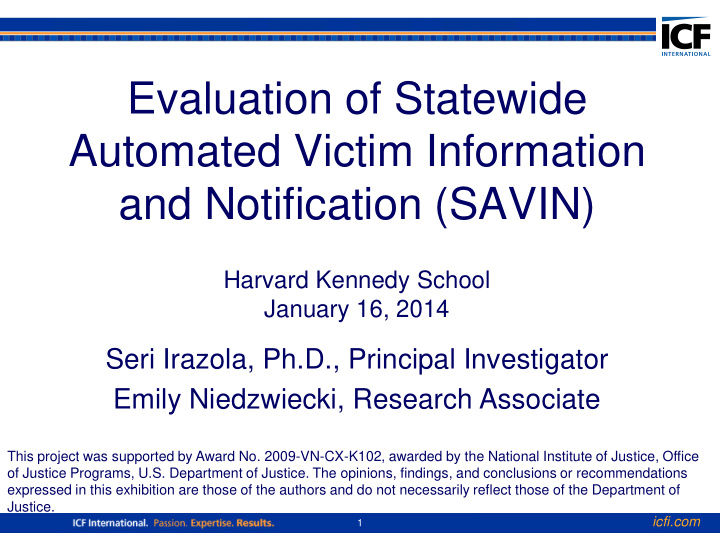



Evaluation of Statewide Automated Victim Information and Notification (SAVIN) Harvard Kennedy School January 16, 2014 Seri Irazola, Ph.D., Principal Investigator Emily Niedzwiecki, Research Associate This project was supported by Award No. 2009-VN-CX-K102, awarded by the National Institute of Justice, Office of Justice Programs, U.S. Department of Justice. The opinions, findings, and conclusions or recommendations expressed in this exhibition are those of the authors and do not necessarily reflect those of the Department of Justice. icfi.com 1
Overview of Automated Victim Notification Notification is an essential victim right Partnering criminal justice agencies Registration • Open vs. closed systems Triggers for notification Modes of notification Bureau of Justice Assistance (BJA) SAVIN Program icfi.com 2
What is SAVIN? icfi.com 3
Methodology Phase I: Landscape • Document Review • Administrator & vendor interviews • Review of legislation • AVN profiles Phase II: Use & Experience with AVN • Surveys of service providers and victims Phase III: Considerations for Practice • Case studies & cost considerations icfi.com 4
Limitations Lack of definition of “Statewide” Evolving evaluation Methodological limitations • Phase I: Administrator turnover & usage data • Phase II: Surveys • Phase III: Cost considerations icfi.com 5
Victim & Service Provider Findings icfi.com 6
Awareness and Use of Automated Notification Use of Automated Registration for Automated Notification Among Victim Notification Among Victims Advocates (n=1,203) (n=716) Non- System Registered, Users, 23% 26% System Non- Users, Registered, 74% 77% icfi.com 7
Overall Satisfaction with Automated Notification System 100% 80% 60% 52% 39% 37% 40% 30% 16% 20% 11% 5% 5% 3% 1% 0% Not at all Not very Somewhat Very satisfied Extremely satisfied satisfied satisfied satisfied Victims (n=150) Victim Advocates (n=675) *Due to rounding percentages do not sum to 100% icfi.com 8
Benefits of Automated Notification 100% 92% 88% 76% 80% 69% 68% 66% 65% 63% 60% 40% 20% 0% Helps victims to Helps victims feel Increases victims' Enhances victims' make decisions more empowered sense of safety participation in their about their safety related legal case Victims* Victim Advocates (n=852) *The victim sample size for each question varied from 134 to 138. icfi.com 9
Experiencing Problems with Automated Notification System 100% 80% 60% 38% 40% 18% 20% 0% Victims (n=134) Victim Advocates (n=400) icfi.com 10
Challenges 100% 80% 60% 48% 47% 40% 25% 21% 21% 17% 17% 17% 20% 13% 13% 13% 13% 0% Inaccurate Not enough Trouble with PIN Difficulty Difficulty using Delayed or notifications notifications registering website to outdated check offender notifications status Challenges Experienced by Victims (n=24) Challenges Experienced by Victim Advocates (n=150) icfi.com 11
Common Themes Manual notification Program costs System awareness Registration Available services Notification process Contact with a live person icfi.com 12
What’s Next? States continue to seek funding streams States continue to find new ways to innovate and more efficiently implement and improve their programs Final Report URL: https://www.ncjrs.gov/pdffiles1/nij/grants/243839. pdf icfi.com 13
For more information, contact: Seri Irazola, Ph.D. seri.irazola@icfi.com (703) 225-2255 Emily Niedzwiecki emily.niedzwiecki@icfi.com (703) 225-2484 icfi.com 14
Recommend
More recommend